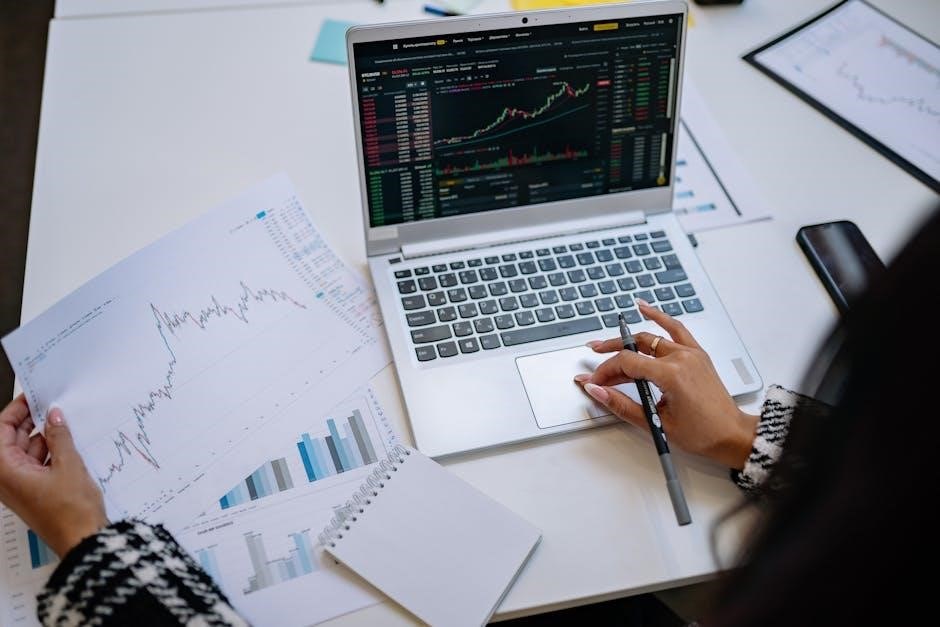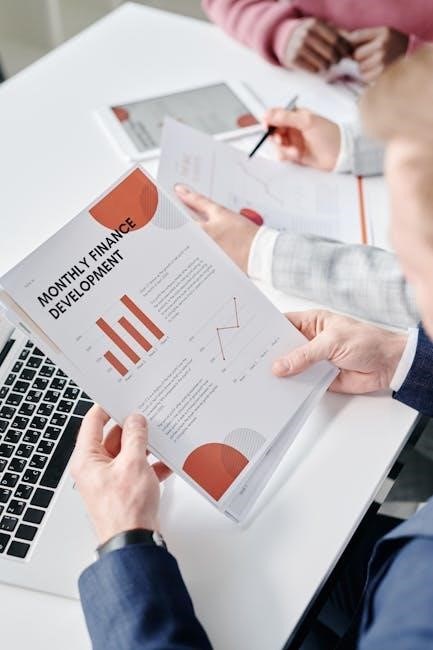
Applied statistics empowers businesses and economists to make data-driven decisions‚ forecast trends‚ and evaluate policies. It bridges theory and practice‚ enabling informed decision-making in dynamic environments.
1.1. Definition of Applied Statistics
Applied statistics refers to the practical application of statistical methods to solve real-world problems in fields such as business and economics. It involves collecting‚ organizing‚ analyzing‚ interpreting‚ and presenting data to draw meaningful conclusions. Unlike theoretical statistics‚ applied statistics focuses on using data to address specific questions or challenges. This discipline is essential for making informed decisions‚ forecasting trends‚ and evaluating the impact of policies or strategies. By transforming raw data into actionable insights‚ applied statistics enables businesses and economists to optimize operations‚ understand consumer behavior‚ and predict economic outcomes. Its versatility makes it a cornerstone of modern decision-making in both corporate and economic contexts.
1.2. Importance of Statistics in Business and Economics
Statistics plays a pivotal role in business and economics by providing a framework for data-driven decision-making. It enables organizations to analyze market trends‚ understand consumer behavior‚ and assess financial risks. In economics‚ statistics is essential for evaluating policy impacts‚ forecasting economic indicators‚ and studying population dynamics. Businesses use statistical tools to optimize operations‚ improve efficiency‚ and gain competitive advantages. By transforming data into actionable insights‚ statistics helps stakeholders make informed choices‚ reduce uncertainty‚ and achieve strategic goals. Its applications span from identifying patterns in economic data to predicting future market conditions‚ making it indispensable for sustainable growth and development in both fields. The reliance on statistical methods ensures that decisions are grounded in evidence rather than intuition.
1.3. Key Concepts and Principles
The foundation of applied statistics in business and economics relies on several key concepts and principles. Descriptive statistics summarize data to understand patterns and trends‚ while inferential statistics draw conclusions about populations from sample data. Probability distributions‚ such as the normal distribution‚ are crucial for modeling uncertainty. Hypothesis testing and confidence intervals provide frameworks for making inferences and measuring uncertainty. Regression analysis helps identify relationships between variables‚ and time series analysis forecasts future trends. Additionally‚ principles like sampling‚ data collection‚ and measurement accuracy ensure reliable results. These concepts form the backbone of statistical analysis‚ enabling businesses and economists to solve problems‚ predict outcomes‚ and inform strategic decisions effectively.

Tools and Techniques in Applied Statistics
Key tools include descriptive statistics‚ hypothesis testing‚ regression analysis‚ and time series analysis. These techniques enable businesses and economists to analyze‚ forecast‚ and make informed decisions effectively.
2.1. Descriptive Statistics
Descriptive statistics involves summarizing and describing datasets to understand key features. It uses measures like mean‚ median‚ mode‚ and standard deviation to highlight central tendencies and variability. Tools such as histograms‚ bar charts‚ and scatter plots visually represent data‚ aiding in pattern identification and trend analysis. In business and economics‚ these techniques are essential for assessing market trends‚ customer behavior‚ and financial performance. By organizing and simplifying complex data‚ descriptive statistics provides a clear foundation for further analysis‚ enabling informed decision-making and strategic planning. Its applications range from evaluating economic indicators to analyzing business performance metrics‚ making it a cornerstone of applied statistics in both fields. This approach ensures that data is interpretable and actionable‚ supporting both academic research and real-world applications.
2.2. Hypothesis Testing
Hypothesis testing is a statistical method used to make inferences about a population based on sample data. It involves formulating a null hypothesis (H₀) and an alternative hypothesis (H₁)‚ then determining whether to reject H₀. This process helps validate assumptions or identify significant differences. In business and economics‚ hypothesis testing is crucial for evaluating theories‚ such as testing the impact of a policy on economic growth or analyzing consumer behavior changes. Common tests include t-tests for comparing means and chi-square tests for categorical data. The results are interpreted using p-values or confidence intervals‚ providing a framework for decision-making. This technique ensures that conclusions are drawn objectively‚ minimizing errors and enhancing the reliability of analysis in applied statistics.
2.3. Regression Analysis
Regression analysis is a statistical method used to establish relationships between variables. It helps predict the value of a dependent variable based on one or more independent variables. In business and economics‚ regression is widely used for forecasting‚ such as predicting sales based on advertising spend or analyzing economic trends. Simple linear regression involves one independent variable‚ while multiple regression incorporates several. Non-linear regression is also applied for complex relationships. Regression models provide insights into variable interactions‚ enabling better decision-making. They are essential tools for identifying trends‚ understanding cause-and-effect relationships‚ and supporting data-driven strategies in both fields. Proper interpretation of regression coefficients and evaluation of model fit are critical for accurate conclusions. This technique is fundamental in applied statistics for solving real-world problems efficiently.
2.4. Time Series Analysis
Time series analysis is a statistical technique used to examine and forecast data collected over time. It helps identify patterns‚ trends‚ and cyclical variations in economic or business data. Common applications include predicting future sales‚ analyzing inventory levels‚ and understanding economic indicators like GDP growth. Techniques such as decomposition‚ ARIMA models‚ and exponential smoothing are widely employed. These methods enable businesses and economists to make accurate forecasts‚ supporting informed decision-making. Time series analysis is particularly useful for understanding seasonal fluctuations and long-term trends. By leveraging historical data‚ organizations can anticipate future events and optimize their strategies. This tool is indispensable in both business and economics for managing uncertainty and planning effectively.
Applications in Business
Applied statistics drives business success by enabling data-driven decision-making‚ market trend analysis‚ and customer behavior insights‚ optimizing operations and strategic planning across industries.
3.1. Financial Analysis and Decision-Making
In the realm of finance‚ applied statistics plays a pivotal role in analyzing market trends‚ assessing risks‚ and forecasting future performance. By employing tools such as regression analysis and time series forecasting‚ businesses can make informed investment decisions and optimize their financial strategies. Statistical methods also enable the evaluation of portfolio performance‚ helping companies to mitigate potential risks and maximize returns. Furthermore‚ the use of hypothesis testing allows financial analysts to identify significant trends and patterns in economic data‚ providing a solid foundation for strategic planning. The integration of statistical techniques into financial decision-making processes ensures that organizations can navigate complex economic landscapes with confidence and precision.
3.2. Market Research and Consumer Behavior
Applied statistics is instrumental in understanding consumer behavior and conducting market research. By analyzing data on purchasing patterns‚ preferences‚ and demographic factors‚ businesses can identify target audiences and tailor their strategies. Statistical tools like regression analysis and hypothesis testing enable companies to assess the effectiveness of marketing campaigns and predict consumer responses. Additionally‚ clustering techniques help segment customers‚ allowing for personalized marketing approaches. These insights empower businesses to make data-driven decisions‚ enhancing their competitiveness and customer satisfaction. The integration of statistical methods into market research ensures a deeper understanding of evolving consumer needs‚ enabling organizations to adapt and thrive in dynamic markets.

Applications in Economics
Applied statistics is crucial in economics for analyzing macroeconomic trends‚ evaluating policies‚ and forecasting economic indicators. It aids in understanding complex systems and informing evidence-based decisions.
4.1. Macroeconomic Analysis
Applied statistics plays a vital role in macroeconomic analysis by enabling the study of economic systems on a large scale. It involves the use of statistical methods to analyze trends in GDP‚ inflation rates‚ unemployment levels‚ and national income. Economists utilize tools like regression analysis and time series forecasting to predict economic cycles and understand the impact of policy changes. Statistical techniques also help in evaluating the effectiveness of fiscal and monetary policies‚ providing insights into economic stability and growth. By applying statistical models‚ researchers can identify patterns and correlations in macroeconomic data‚ aiding in the development of evidence-based economic strategies. This integration of statistics and economics ensures that decisions are grounded in data‚ fostering a deeper understanding of complex economic phenomena.
4.2. Policy Evaluation
Applied statistics is instrumental in evaluating the effectiveness of economic policies by providing a data-driven framework for analysis. Statistical methods such as regression analysis and hypothesis testing enable researchers to assess the impact of policies on economic outcomes like employment‚ income‚ and inflation. By analyzing large datasets‚ policymakers can identify trends and measure the success of interventions. Statistical tools also help in predicting the potential effects of proposed policies‚ allowing for more informed decision-making. This empirical approach ensures that policy evaluations are objective and grounded in real-world data‚ enabling governments and organizations to allocate resources efficiently and address economic challenges effectively. Applied statistics thus plays a crucial role in shaping evidence-based policies that drive economic growth and stability.

Case Studies and Real-World Examples
Real-world examples demonstrate how applied statistics solves business and economic challenges. Case studies highlight practical applications of statistical methods in forecasting‚ market research‚ and policy analysis.
5.1. Business Case Studies
Business case studies illustrate the practical application of applied statistics in real-world scenarios. For instance‚ companies use statistical tools to analyze customer behavior‚ optimize pricing strategies‚ and forecast sales trends. Regression analysis helps identify relationships between variables‚ guiding decision-making. Hypothesis testing is employed to validate marketing campaigns’ effectiveness. These examples demonstrate how statistical methods solve business challenges‚ enhancing operational efficiency and profitability. Case studies from textbooks like “Applied Statistics in Business and Economics” provide detailed insights into these applications. They highlight the role of data-driven approaches in competitive markets‚ offering students and professionals actionable lessons. Such real-world applications bridge theory and practice‚ making statistical concepts more relatable and useful in everyday business operations.
5.2. Economic Case Studies
Economic case studies demonstrate how applied statistics are used to analyze macroeconomic trends and policy impacts. For example‚ statistical methods like regression analysis are employed to study GDP growth‚ inflation rates‚ and unemployment trends. Hypothesis testing helps evaluate the effectiveness of fiscal and monetary policies. Time series analysis is used to forecast economic indicators‚ guiding policymakers and researchers. Case studies from textbooks such as “Applied Statistics in Business and Economics” highlight real-world applications‚ showing how statistical tools aid in understanding economic phenomena. These studies emphasize the importance of data-driven decision-making in shaping economic strategies and evaluating their outcomes‚ providing valuable insights for both policymakers and academics.

Future Trends in Applied Statistics
Emerging trends include the integration of Big Data‚ machine learning‚ and artificial intelligence in statistical analysis. These advancements enable more precise forecasting and dynamic decision-making in business and economics.
6.1. Big Data and Machine Learning
The integration of Big Data and machine learning into applied statistics is revolutionizing business and economics. These technologies enable the analysis of vast‚ complex datasets‚ uncovering patterns and insights that traditional methods might miss. Machine learning algorithms‚ such as neural networks and decision trees‚ are increasingly used for predictive analytics‚ helping organizations forecast market trends‚ optimize pricing‚ and improve risk assessment. The combination of Big Data and machine learning also enhances real-time decision-making‚ allowing businesses to respond swiftly to market changes. As data-driven approaches become more sophisticated‚ they are reshaping how statistics is applied in both academic and professional settings‚ providing a powerful toolkit for addressing modern economic and business challenges effectively. This trend underscores the growing importance of advanced analytical skills in the field.
6.2. Artificial Intelligence in Statistics
Artificial Intelligence (AI) is transforming the field of applied statistics by automating complex analytical tasks and enhancing decision-making processes. AI algorithms can process large datasets with remarkable speed and accuracy‚ identifying patterns that might elude traditional statistical methods. Machine learning‚ a subset of AI‚ enables predictive modeling‚ clustering‚ and classification‚ which are invaluable in business forecasting and economic analysis. AI also streamlines data preparation‚ reducing manual effort in cleaning and transforming data. Moreover‚ AI-driven tools are making advanced statistical techniques more accessible to non-experts‚ fostering broader adoption in business and economics. As AI continues to evolve‚ it promises to revolutionize how statistical insights are generated and applied‚ ensuring more efficient and informed decision-making across industries. This integration of AI with statistics is a pivotal trend shaping the future of data analysis.
6.3. Globalization of Economic Data
The globalization of economic data has created a interconnected world where businesses and economists must analyze international trends and cross-border interactions. Applied statistics plays a crucial role in understanding these complex patterns‚ enabling organizations to make informed decisions in a globalized market. With data spanning multiple regions and currencies‚ statistical methods help identify opportunities and risks associated with international trade and investment. The integration of global economic data also facilitates comparative analysis‚ allowing for a deeper understanding of economic systems worldwide. As globalization continues to expand‚ the demand for advanced statistical tools to interpret and forecast global economic trends will grow‚ making applied statistics indispensable in this interconnected era.
Resources and References
Recommended textbooks include “Applied Statistics in Business and Economics” by Doane and Seward‚ offering practical examples and Excel exercises. Online courses and PDF resources provide supplementary learning aids.
7.1. Recommended Textbooks
Several textbooks are highly recommended for studying applied statistics in business and economics. One of the most popular is “Applied Statistics in Business and Economics” by David P. Doane‚ which offers a comprehensive approach with practical examples and Excel exercises. Another widely used resource is “Statistics for Business and Economics” by Paul Newbold‚ William Carlson‚ and Betty Thorne‚ known for its clear explanations and real-world applications. Additionally‚ “Applied Statistics for Business and Economics” by Robert M. Leekley provides a concise yet thorough introduction to statistical methods. These textbooks are available in various editions‚ including PDF formats‚ and are essential for both students and professionals seeking to master applied statistics in business and economic contexts.
7.2. Online Courses and Tutorials
and edX’s “Statistics for Business” are highly recommended. These courses often include downloadable PDF materials‚ such as lecture notes and exercises. Additionally‚ websites like DataCamp and Udemy offer hands-on tutorials with practical examples. Many of these resources are designed to complement textbooks like Doane’s Applied Statistics in Business and Economics‚ ensuring a comprehensive learning experience. These online resources are invaluable for those seeking to enhance their analytical skills in a data-driven world.